3,3′,5,5′-Tetrabromobiphenyl (BB-80) and Its Hydroxylation Product (OH-BB-80) Mediate Immunotoxicity and Inhibit Embryonic Development in Zebrafish (Danio rerio) via the TLR4/NF-κB Signaling Pathway
Abstract
1. Introduction
2. Materials and Methods
2.1. Chemicals
2.2. Zebrafish Maintenance and Exposure Experiment Design
2.3. Measurement of BB-80 and OH-BB-80 Concentration Levels in the Exposure Solution
2.4. Evaluation of Embryonic Developmental Toxicity
2.5. Oxidative Stress Tests
2.6. Gene Expression Analysis
2.7. Cytokine Enzyme-Linked Immunosorbent Assay (ELISA)
2.8. Molecular Docking
2.9. Statistical Analysis
3. Results and Discussion
3.1. Changes in the Concentration of BB-80 and OH-BB-80 in the Exposure Fluid After 24 h
3.2. BB-80 and OH-BB-80 Inhibit Early Growth and Development in Zebrafish
3.3. BB-80 and OH-BB-80 Induce Oxidative Stress in Juvenile Zebrafish
3.4. BB-80 and OH-BB-80 Trigger Inflammatory Responses in Juvenile Zebrafish
3.5. BB-80 and OH-BB-80 Activate the TLR4/NF-κB Innate Immune Signaling Pathway to Induce an Inflammatory Response
4. Conclusions
Supplementary Materials
Author Contributions
Funding
Institutional Review Board Statement
Informed Consent Statement
Data Availability Statement
Conflicts of Interest
References
- Varshney, S.; Gora, A.H.; Siriyappagouder, P.; Kiron, V.; Olsvik, P.A. Toxicological effects of 6PPD and 6PPD quinone in zebrafish larvae. J. Hazard. Mater. 2022, 424, 127623. [Google Scholar] [CrossRef]
- Wattigney, W.A.; Irvin-Barnwell, E.; Li, Z.; Ragin-Wilson, A. Biomonitoring of toxic metals, organochlorine pesticides, and polybrominated biphenyl 153 in Michigan urban anglers. Environ. Res. 2022, 203, 111851. [Google Scholar] [CrossRef] [PubMed]
- Terrell, M.L.; Berzen, A.K.; Small, C.M.; Cameron, L.L.; Wirth, J.J.; Marcus, M. A cohort study of the association between secondary sex ratio and parental exposure to polybrominated biphenyl (PBB) and polychlorinated biphenyl (PCB). Environ. Health 2009, 8, 35. [Google Scholar] [CrossRef] [PubMed]
- Zhao, G.; Wang, Z.; Dong, M.H.; Rao, K.; Luo, J.; Wang, D.; Zha, J.; Huang, S.; Xu, Y.; Ma, M. PBBs, PBDEs, and PCBs levels in Hair of Residents Around E-Waste Disassembly Sites in Zhejiang Province, China, and Their Potential Sources. Sci. Total Environ. 2008, 397, 46–57. [Google Scholar] [CrossRef] [PubMed]
- Ni, H.; Zeng, H.; Tao, S.; Zeng, E. Environmental and human exposure to persistent halogenated compounds derived from e-waste in China. Environ. Toxicol. Chem. 2010, 29, 1237–1247. [Google Scholar] [CrossRef]
- Technical Fact Sheet—Polybrominated biphenyls (PBBs). U.S. Environ. Prot. Agency. 2017. Available online: https://www.epa.gov/sites/default/files/2017-12/documents/ffrro_factsheet_pbb_11-16-17_508.pdf (accessed on 1 October 2024).
- Zhao, H.; Jiang, J.; Wang, Y.; Lehmler, H.J.; Buettner, G.R.; Quan, X.; Chen, J. Monohydroxylated polybrominated diphenyl Ethers (OH-PBDEs) and dihydroxylated polybrominated biphenyls (Di-OH-PBBs): Novel photoproducts of 2,6-dibromophenol. Environ. Sci. Technol. 2015, 49, 14120–14128. [Google Scholar] [CrossRef]
- Kato, Y.; Okada, S.; Atobe, K.; Tetsuya, E.; Futoshi, M.; Takayoshi, O.; Koichi, H. Simultaneous determination by APCI-LC/MS/MS of hydroxylated and methoxylated polybrominated diphenyl ethers found in marine biota. Anal. Chim. Acta 2009, 81, 5942–5948. [Google Scholar] [CrossRef]
- Marsh, G.; Athanasiadou, M.; Athanassiadis, I.; Bergman, A.; Endo, T.; Haraguchi, K. Identification, quantification, and synthesis of a novel dimethoxylated polybrominated biphenyl in marine mammals caught off the coast of Japan. Environ. Sci. Technol. 2005, 39, 8684–8690. [Google Scholar] [CrossRef]
- Letcher, R.J.; Gebbink, W.A.; Sonne, C.; Born, E.W.; McKinney, M.A.; Dietz, R. Bioaccumulation and biotransformation of brominated and chlorinated contaminants and their metabolites in ringed seals (Pusa hispida) and polar bears (Ursus maritimus) from East Greenland. Environ. Int. 2009, 35, 1118–1124. [Google Scholar] [CrossRef]
- Susan, S.H.; Liang, D.; Robert, B.H.; Tan, Y.; Metrecia, L.T.; Marder, M.E.; Barton, H.; Melanie, A.P.; Douglas, I.W.; Dana, B.B.; et al. Assessing Metabolic Differences Associated with Exposure to Polybrominated Biphenyl and Polychlorinated Biphenyls in the Michigan PBB Registry. Environ. Health Perspect. 2023, 131, 107005. [Google Scholar]
- Bekesi, J.G.; James, F.H.; Anderson, H.A.; Fischbein, A.S.; Rom, W.; Wolff, M.S.; Selikoff, I.J. Lymphocyte Function of Michigan Dairy Farmers Exposed to Polybrominated Biphenyls. Science 1978, 199, 1207–1209. [Google Scholar] [CrossRef]
- Wang, K.; Huang, Y.; Cheng, B.; Guo, J.; Peng, Y.; Zeng, S.; Zhang, J.; Lu, H. Sulfoxaflor induces immunotoxicity in zebrafish (Danio rerio) by activating TLR4/NF-κB signaling pathway. Fish Shellfish. Immunol. 2023, 137, 108743. [Google Scholar] [CrossRef]
- Pei, J.; Chen, S.; Ke, Q.; Pang, A.; Niu, M.; Li, N.; Li, J.; Wang, Z.; Wu, H.; Nie, P. Immune response to polystyrene microplastics: Regulation of inflammatory response via the ROS-driven NF-κB pathway in zebrafish (Danio rerio). Aquat. Toxicol. 2025, 282, 107308. [Google Scholar] [CrossRef] [PubMed]
- Amemiya, C.T.; Zhong, T.P.; Silverman, G.A.; Fishman, M.C.; Zon, L. Zebrafish YAC, BAC, and PAC genomic libraries. Methods Cell Biol. 1999, 60, 235–258. [Google Scholar] [PubMed]
- Blechinger, S.R.; Warren, J.T.; Kuwada, J.Y.; Krone, P.H. Developmental Toxicology of Cadmium in Living Embryos of a Stable Transgenic Zebrafish Line. Environ. Health Perspect. 2002, 110, 1041–1046. [Google Scholar] [CrossRef]
- Fraysse, B.; Mons, R.; Garric, J. Development of a zebrafish 4-day embryo-larval bioassay to assess toxicity of chemicals. Ecotoxicol. Environ. Saf. 2006, 63, 253–267. [Google Scholar] [CrossRef] [PubMed]
- Wang, X.; Du, T.; Wang, J.; Kou, H.; Du, X. Determination of polybrominated biphenyls in environmental water samples by ultrasound-assisted dispersive liquid-liquid microextraction followed by high-performance liquid chromatography. Microchem. J. 2019, 148, 85–91. [Google Scholar] [CrossRef]
- Parlak, V. Evaluation of apoptosis, oxidative stress responses, AChE activity and body malformations in zebrafish (Danio rerio) embryos exposed to deltamethrin. Chemosphere 2018, 207, 397–403. [Google Scholar] [CrossRef]
- Li, H.; Cao, F.; Zhao, F.; Yang, Y.; Teng, M.; Wang, C.; Qiu, L. Developmental toxicity, oxidative stress and immunotoxicity induced by three strobilurins (pyraclostrobin, trifloxystrobin and picoxystrobin) in zebrafish embryos. Chemosphere 2018, 207, 781–790. [Google Scholar] [CrossRef]
- Jin, Y.; Liu, Z.; Peng, T.; Fu, Z. The toxicity of chlorpyrifos on the early life stage of zebrafish: Asurvey on the endpoints at development, locomotor behavior, oxidative stress and immunotoxicity. Fish Shellfish. Immunol. 2015, 43, 405–414. [Google Scholar] [CrossRef]
- Scientific Opinion on Polybrominated Biphenyls (PBBs) in Food. EFSA J. 2010, 8, 1789. [CrossRef]
- Valavanidis, A.; Vlahogianni, T.; Dassenakis, M.; Scoullos, M. Molecular biomarkers of oxidative stress in aquatic organisms in relation to toxic environmental pollutants. Ecotoxicol. Environ. Saf. 2006, 64, 178–189. [Google Scholar] [CrossRef] [PubMed]
- Shi, X.; Zhou, B. The Role of Nrf2 and MAPK Pathways in PFOS-Induced Oxidative Stress in Zebrafish Embryos. Toxicol. Sci. 2010, 115, 391–400. [Google Scholar] [CrossRef] [PubMed]
- Shnayder, N.A.; Petrova, M.M.; Moskaleva, P.V.; Shesternya, P.P.; Pozhilenkova, E.A.; Nasyrova, R.F. The Role of Single Nucleotide Variants of NOS1, NOS2, and NOS3 Genes in the Development of the Phenotype of Migraine and Arterial Hypertension. Brain Sci. 2021, 11, 753. [Google Scholar] [CrossRef]
- Jin, Y.; Zhang, X.; Shu, L.; Chen, L.; Sun, L.; Qian, H.; Liu, W.; Fu, Z. Oxidative stress response and gene expression with atrazine exposure in adult female zebrafish (Danio rerio). Chemosphere 2010, 78, 846–852. [Google Scholar] [CrossRef]
- Shi, X.; Gu, A.; Ji, G.; Li, Y.; Di, J.; Jin, J.; Hu, F.; Long, Y.; Xia, Y.; Lu, C.; et al. Developmental toxicity of cypermethrin in embryo-larval stages of zebrafish. Chemosphere 2011, 85, 1010–1016. [Google Scholar] [CrossRef]
- Maranhao, H.M.; Vasconcelos, C.F.; Rolim, L.A.; Neto, P.J.; Neto, J.C.; Filho, R.C.; Fernandes, M.P.; Costa-Silva, J.H.; Araújo, A.V.; Wanderley, A.G. Hepatoprotective Effect of the Aqueous Extract of Simarouba amara Aublet (Simaroubaceae) Stem Bark against Carbon Tetrachloride (CCl4)-Induced Hepatic Damage in Rats. Molecules 2014, 19, 17735–17746. [Google Scholar] [CrossRef]
- Mansuri, M.S.; Jadeja, S.D.; Singh, M.; Laddha, N.C.; Dwivedi, M.; Begum, R. The catalase gene promoter and 5′-untranslated region variants lead to altered gene expression and enzyme activity in vitiligo. Br. J. Dermatol. 2017, 177, 1590–1600. [Google Scholar] [CrossRef]
- Zhang, L.; Dong, L.; Liao, H. Survival strategies of bacteria in response to excessive reactive oxygen species: A review. Microbiol. China 2021, 48, 1249–1259. [Google Scholar]
- Mittal, M.; Siddiqui, M.R.; Tran, K.; Reddy, S.P.; Malik, A.B. Reactive oxygen species in inflammation and tissue injury. Antioxid. Redox Signal. 2014, 20, 1126–1167. [Google Scholar] [CrossRef]
- Tisoncik, J.R.; Korth, M.J.; Simmons, C.P.; Farrar, J.; Martin, T.R.; Katze, M.G. Into the eye of the cytokine storm. Microbiol. Mol. Biol. Rev. 2012, 76, 16–32. [Google Scholar] [CrossRef] [PubMed]
- Mulero, M.C.; Huang, D.B.; Nguyen, H.T.; Wang, V.Y.; Li, Y.; Biswas, T.; Ghosh, G. DNA-binding affinity and transcriptional activity of the RelA homodimer of nuclear factor κB are not correlated. J. Biol. Chem. 2017, 292, 18821–18830. [Google Scholar] [CrossRef] [PubMed]
- Katare, P.B.; Nizami, H.L.; Paramesha, B.; Dinda, A.K.; Banerjee, S.K. Activation of toll like receptor 4 (TLR4) promotes cardiomyocyte apoptosis through SIRT2 dependent p53 deacetylation. Sci. Rep. 2020, 10, 19232. [Google Scholar] [CrossRef]
- Kumar, V. Toll-Like Receptors in Adaptive Immunity. In Handbook of Experimental Pharmacology; Springer: Cham, Switzerland, 2021. [Google Scholar]
- Lawrence, T. The nuclear factor NF-κB pathway in inflammation. Cold Spring Harb. Perspect. Biol. 2009, 1, a001651. [Google Scholar] [CrossRef] [PubMed]
- Loo, Y.M.; Gale, M., Jr. Immune signaling by RIG-I-like receptors. Immunity 2011, 34, 680–692. [Google Scholar] [CrossRef]
- Ibsen, M.S.; Gad, H.H.; Andersen, L.L.; Hornung, V.; Julkunen, I.; Sarkar, S.N.; Hartmann, R. Structural and functional analysis reveals that human OASL binds dsRNA to enhance RIG-I signaling. Nucleic Acids Res. 2015, 43, 5236–5248. [Google Scholar] [CrossRef]
- Jacobs, J.L.; Coyne, C.B. Mechanisms of MAVS regulation at the mitochondrial membrane. J. Mol. Biol. 2013, 425, 5009–5019. [Google Scholar] [CrossRef]
- Chovanova, L.; Vlcek, M.; Krskova, K.; Penesova, A.; Radikova, Z.; Rovensky, J.; Cholujova, D.; Sedlak, J.; Imrich, R. Increased production of IL-6 and IL-17 in lipopolysaccharide-stimulated peripheral mononuclears from patients with rheumatoid arthritis. Gen. Physiol. Biophys. 2013, 32, 395–404. [Google Scholar] [CrossRef][Green Version]
- Tang, C.H.; Hsu, C.J.; Yang, W.H.; Fong, Y.C. Lipoteichoic acid enhances IL-6 production in human synovial fibroblasts via TLR2 receptor, PKCdelta and c-Src dependent pathways. Biochem. Pharmacol. 2010, 79, 1648–1657. [Google Scholar] [CrossRef]
- Resman, N.; Oblak, A.; Gioannini, T.; Weiss, J.; Jerala, R. Tetraacylated lipid A and paclitaxel-selective activation of TLR4/MD-2 conferred through hydrophobic interactions. J. Immunol. 2014, 192, 1887–1895. [Google Scholar] [CrossRef]
- Liu, H.; Nie, F.H.; Lin, H.Y.; Ma, Y.; Ju, X.H.; Chen, J.J. Developmental toxicity, oxidative stress, and related gene expression induced by dioxin-like PCB126 in zebrafish (Danio rerio). Environ. Toxicol. 2016, 31, 295–303. [Google Scholar] [CrossRef] [PubMed]
- Zhang, X.; Sun, Y.; Gao, Y. Thyroid dysfunction of zebrafish (Danio rerio) after early-life exposure and discontinued exposure to tetrabromobiphenyl (BB-80) and OH-BB-80. Environ. Sci. Technol. 2022, 56, 2519–2528. [Google Scholar] [CrossRef] [PubMed]
- Ni, A.; Fang, L.; Xi, M. Neurotoxic effects of 2-ethylhexyl diphenyl phosphate exposure on zebrafish larvae: Insight into inflammation-driven changes in early motor behavior. Sci. Total Environ. 2024, 915, 170131. [Google Scholar] [CrossRef] [PubMed]
- Wu, Y.; Wang, Y.; Tong, Z. Pyraclostrobin induces developmental toxicity and cardiotoxicity through oxidative stress and inflammation in zebrafish embryos. Environ. Pollut. 2024, 358, 124490. [Google Scholar] [CrossRef]
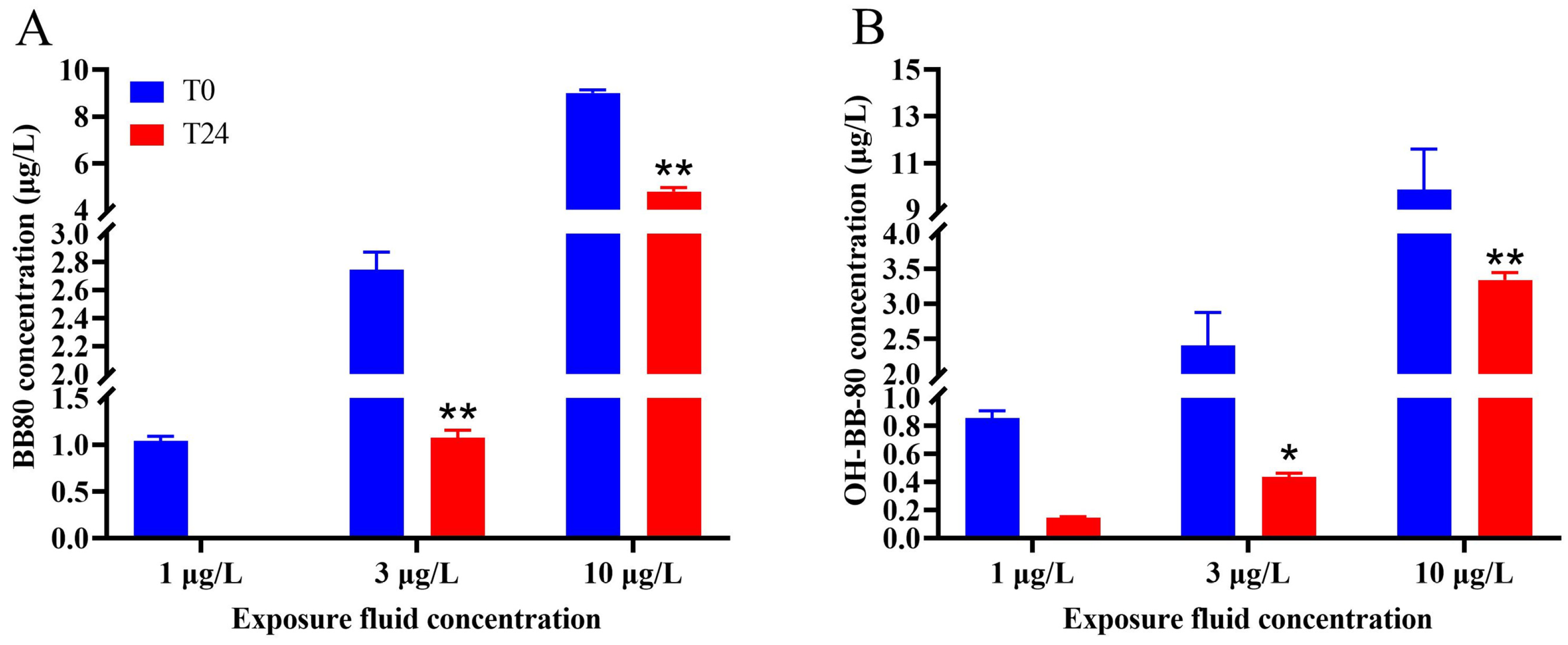
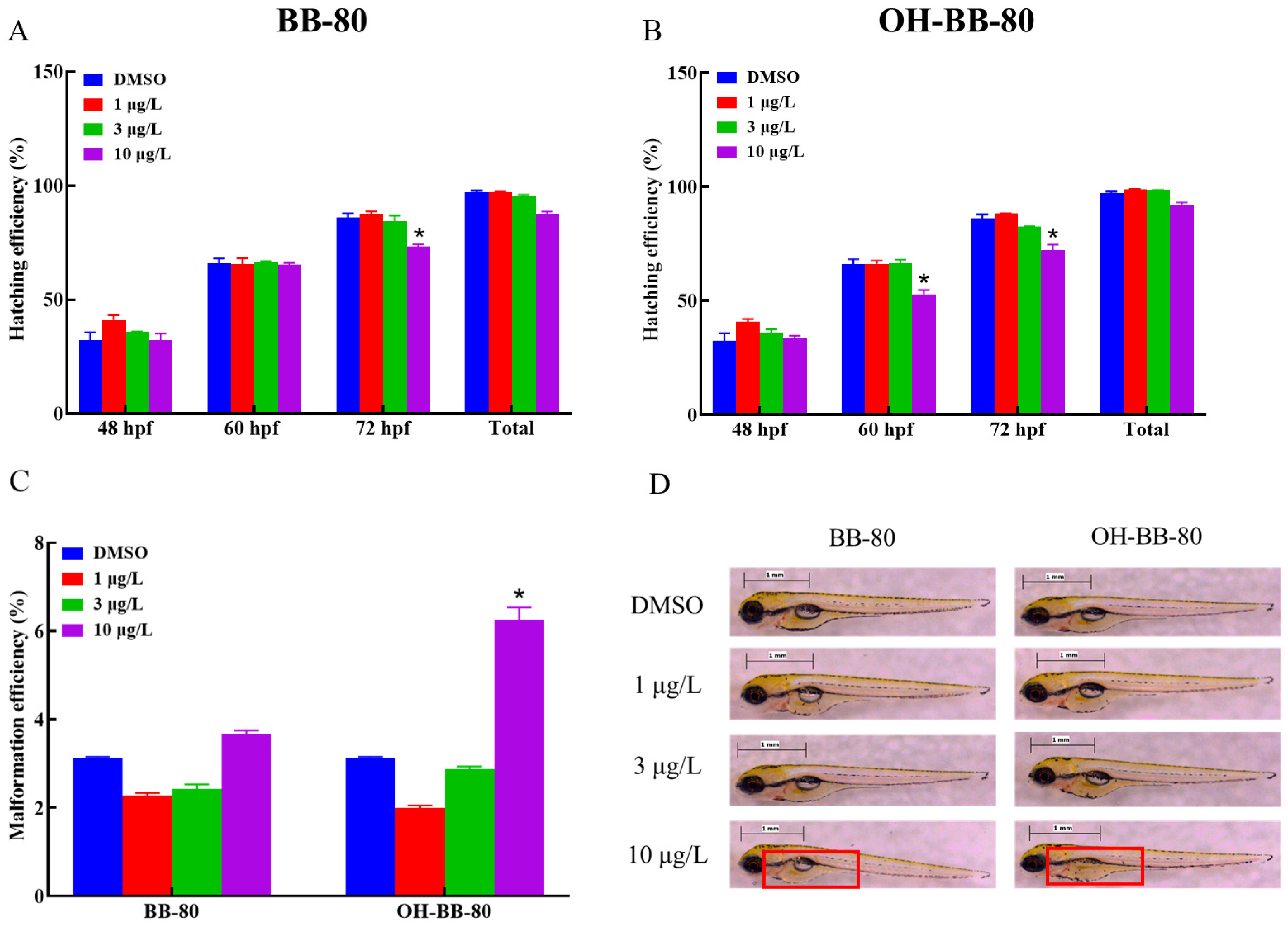
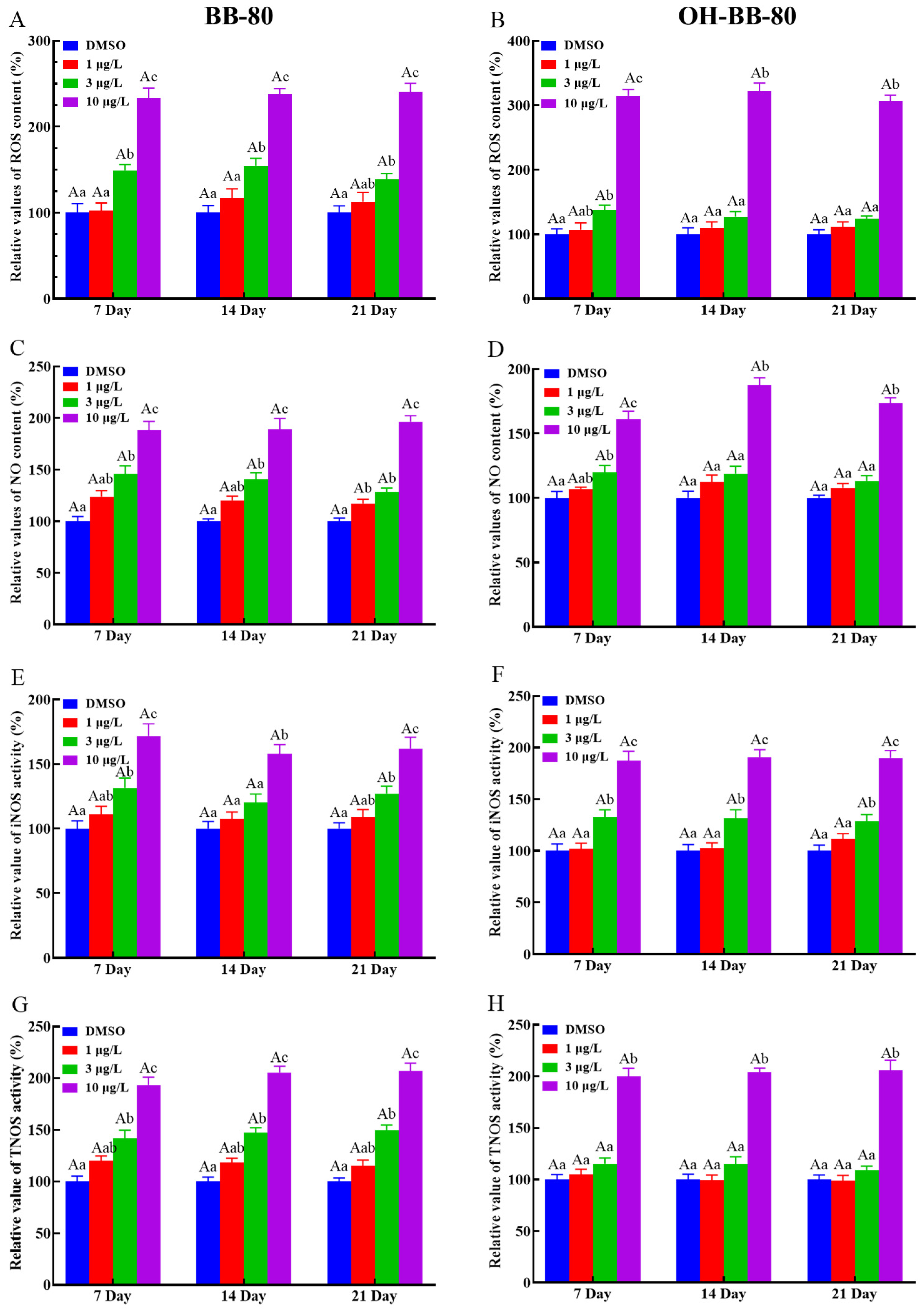
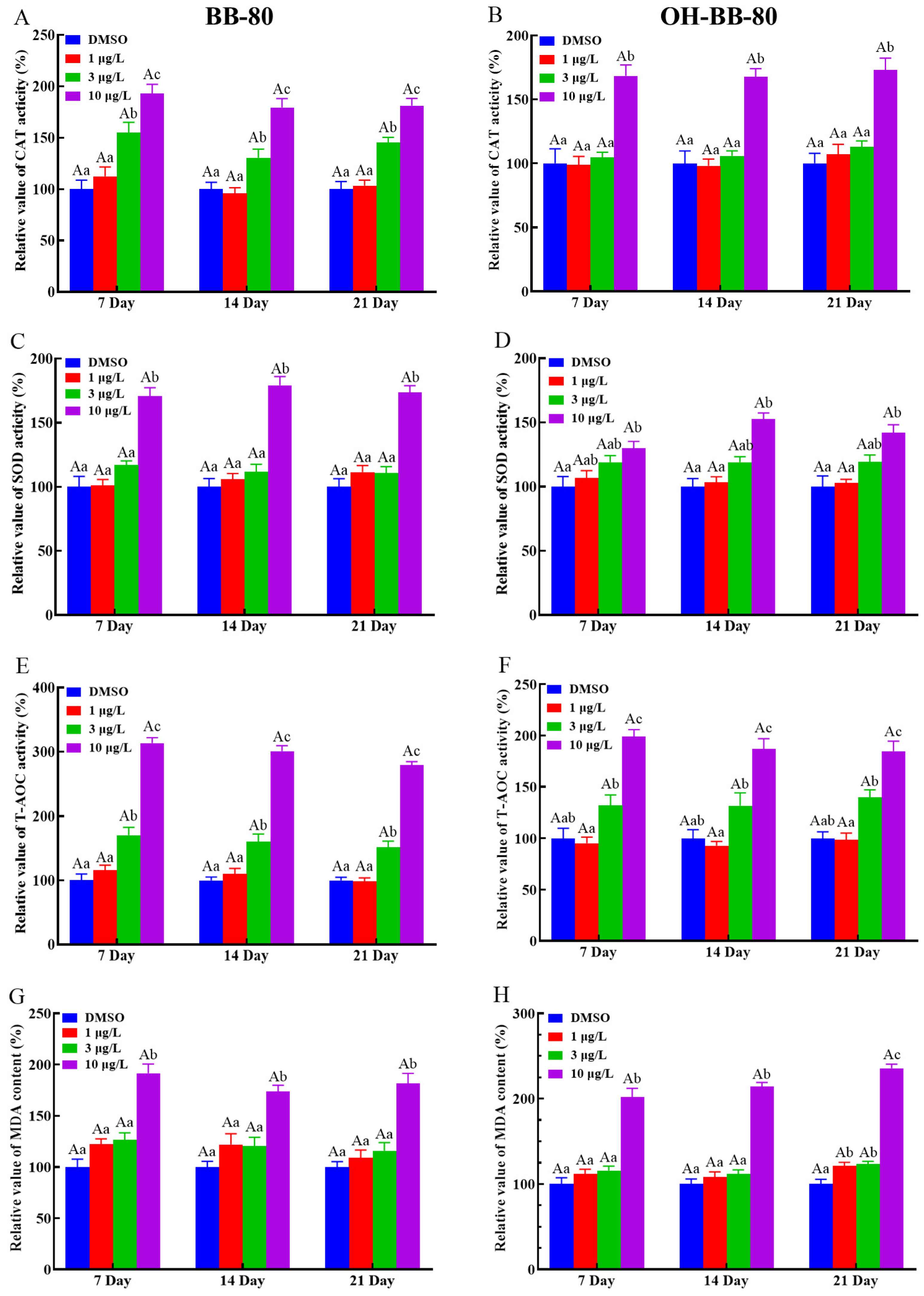

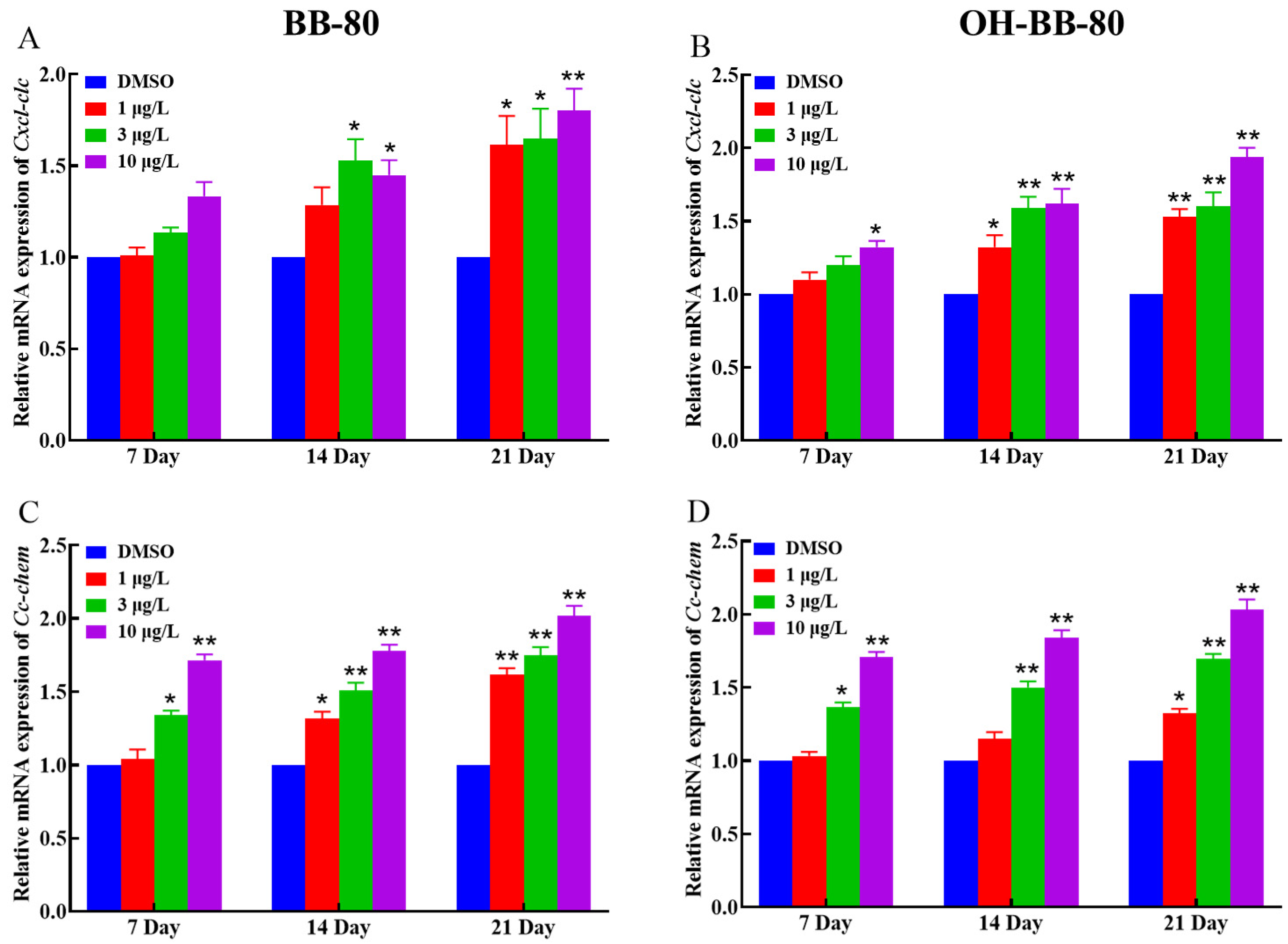
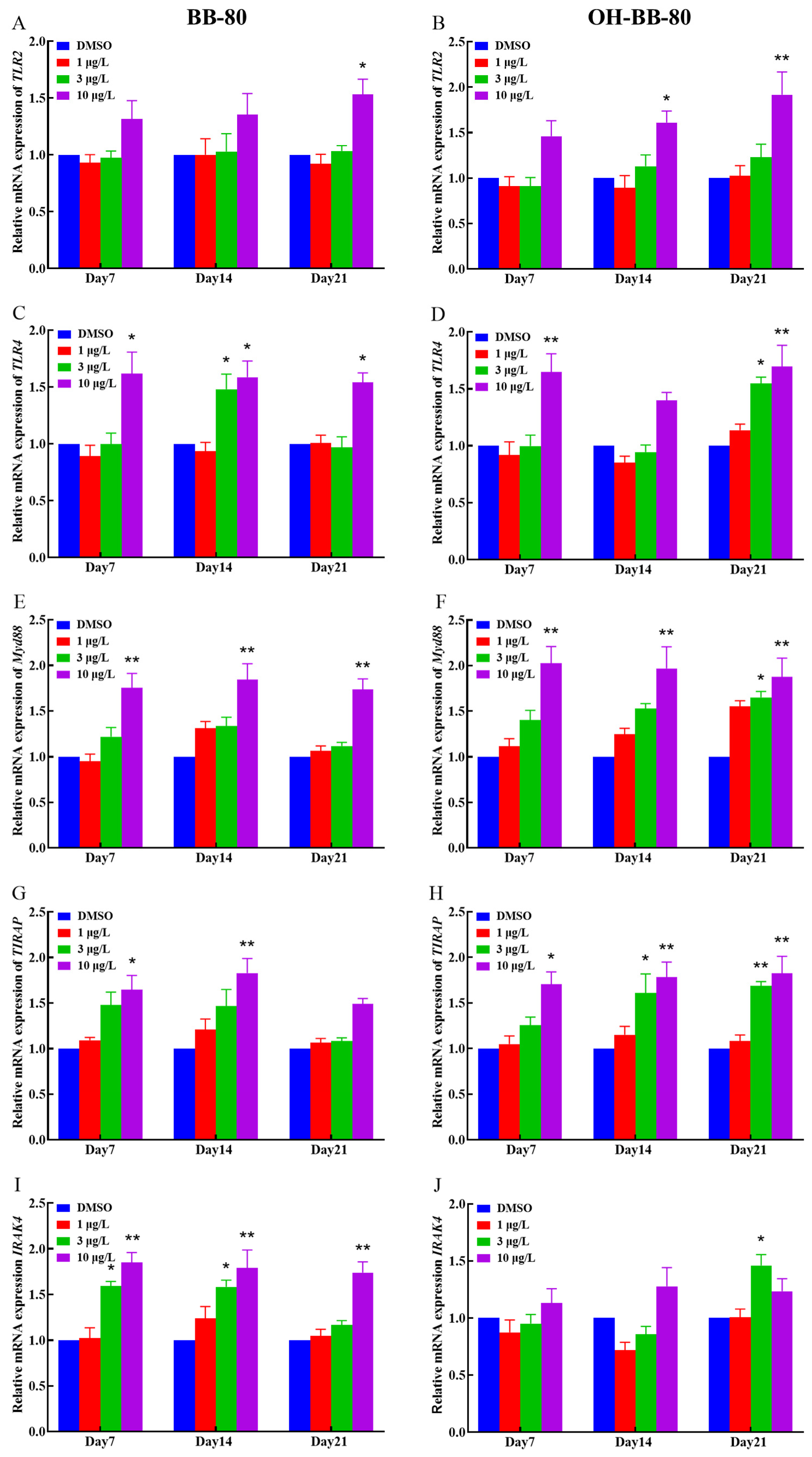
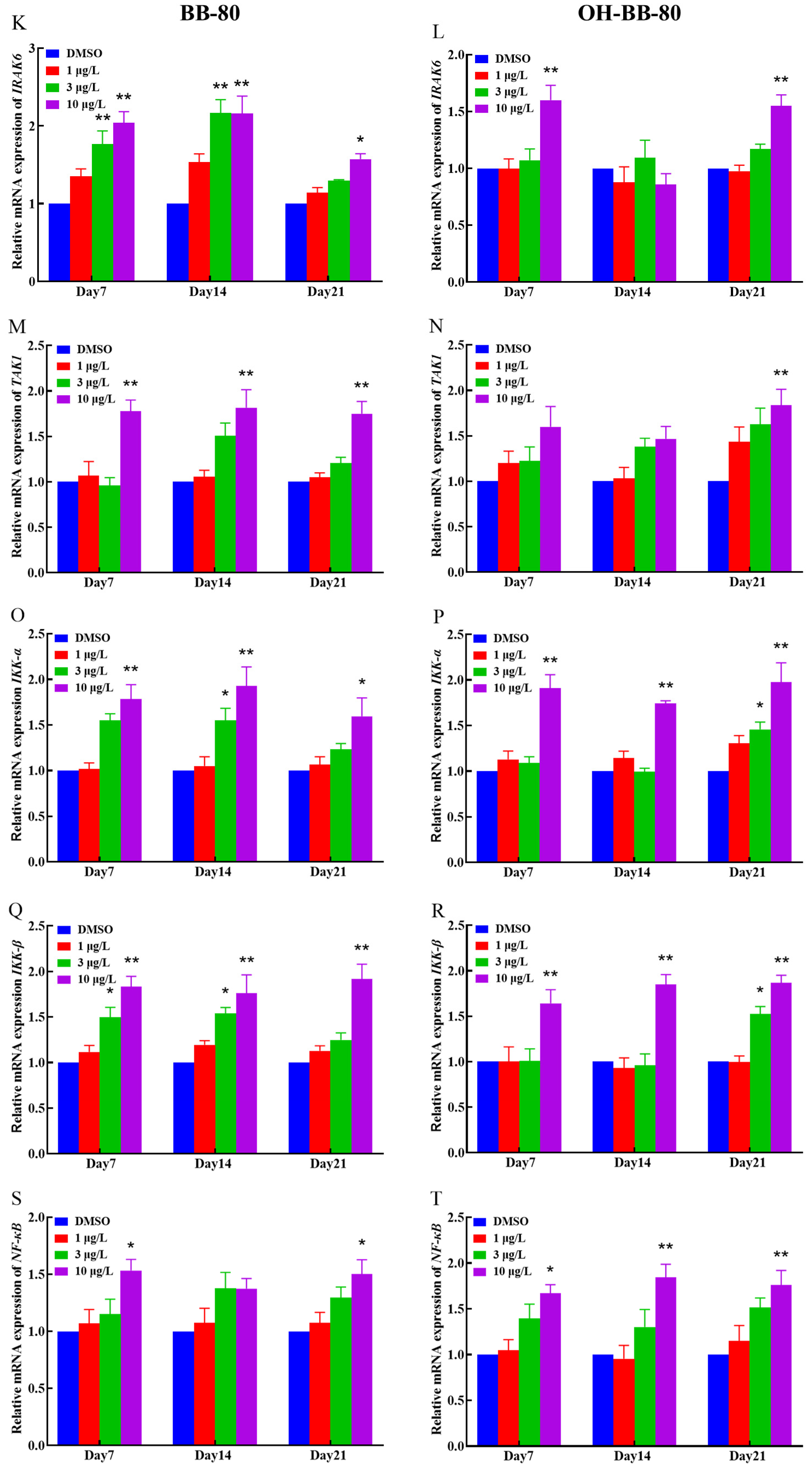

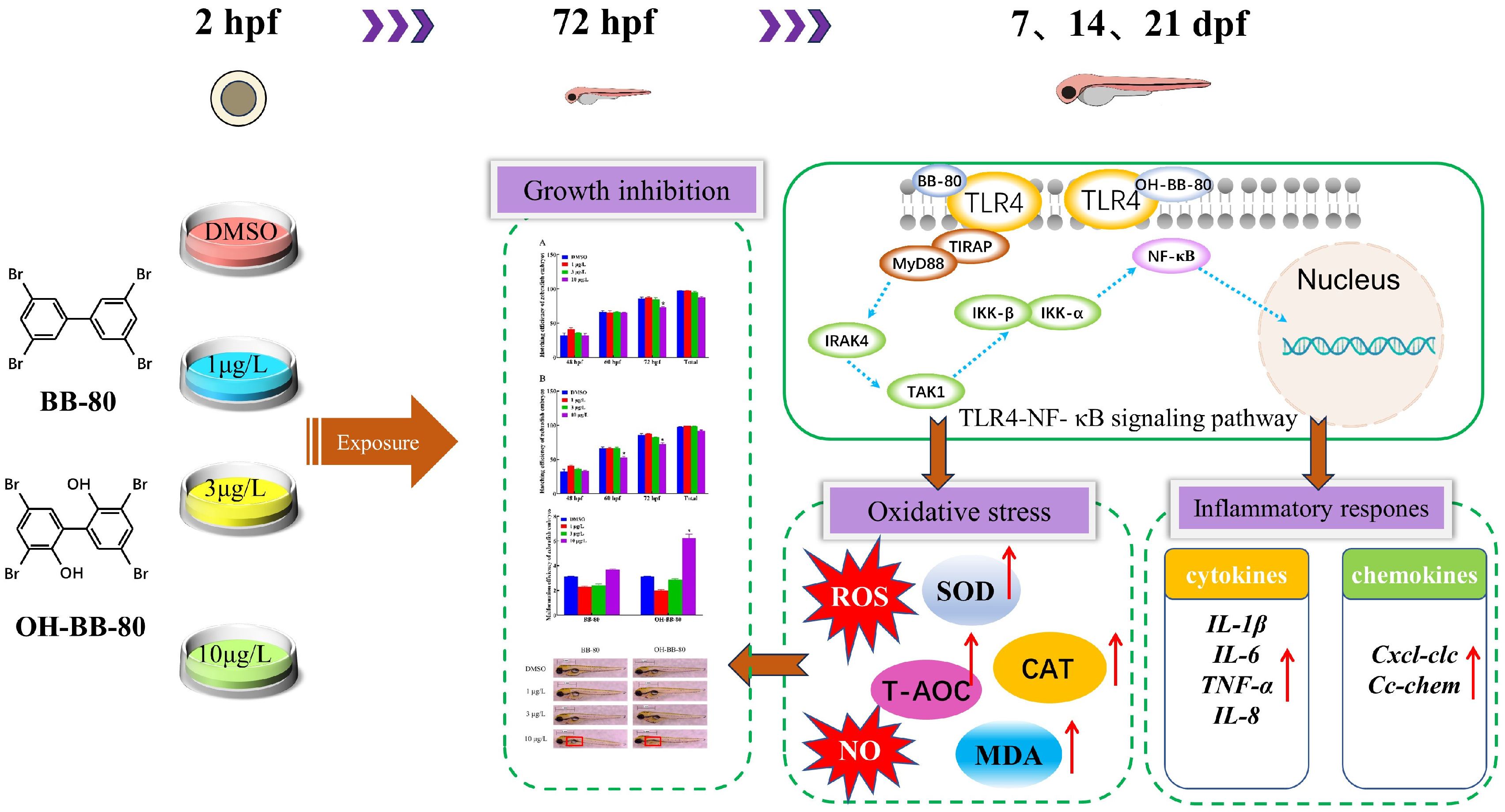
Disclaimer/Publisher’s Note: The statements, opinions and data contained in all publications are solely those of the individual author(s) and contributor(s) and not of MDPI and/or the editor(s). MDPI and/or the editor(s) disclaim responsibility for any injury to people or property resulting from any ideas, methods, instructions or products referred to in the content. |
© 2025 by the authors. Licensee MDPI, Basel, Switzerland. This article is an open access article distributed under the terms and conditions of the Creative Commons Attribution (CC BY) license (https://creativecommons.org/licenses/by/4.0/).
Share and Cite
Shao, Y.; Zhang, Y.; Zhang, X.; Han, Y.; Liu, Z.; Ding, J.; Wang, B.; Zhang, H. 3,3′,5,5′-Tetrabromobiphenyl (BB-80) and Its Hydroxylation Product (OH-BB-80) Mediate Immunotoxicity and Inhibit Embryonic Development in Zebrafish (Danio rerio) via the TLR4/NF-κB Signaling Pathway. Toxics 2025, 13, 293. https://doi.org/10.3390/toxics13040293
Shao Y, Zhang Y, Zhang X, Han Y, Liu Z, Ding J, Wang B, Zhang H. 3,3′,5,5′-Tetrabromobiphenyl (BB-80) and Its Hydroxylation Product (OH-BB-80) Mediate Immunotoxicity and Inhibit Embryonic Development in Zebrafish (Danio rerio) via the TLR4/NF-κB Signaling Pathway. Toxics. 2025; 13(4):293. https://doi.org/10.3390/toxics13040293
Chicago/Turabian StyleShao, Yongjian, Yinan Zhang, Xiaofang Zhang, Yu Han, Zhiquan Liu, Jiafeng Ding, Binhao Wang, and Hangjun Zhang. 2025. "3,3′,5,5′-Tetrabromobiphenyl (BB-80) and Its Hydroxylation Product (OH-BB-80) Mediate Immunotoxicity and Inhibit Embryonic Development in Zebrafish (Danio rerio) via the TLR4/NF-κB Signaling Pathway" Toxics 13, no. 4: 293. https://doi.org/10.3390/toxics13040293
APA StyleShao, Y., Zhang, Y., Zhang, X., Han, Y., Liu, Z., Ding, J., Wang, B., & Zhang, H. (2025). 3,3′,5,5′-Tetrabromobiphenyl (BB-80) and Its Hydroxylation Product (OH-BB-80) Mediate Immunotoxicity and Inhibit Embryonic Development in Zebrafish (Danio rerio) via the TLR4/NF-κB Signaling Pathway. Toxics, 13(4), 293. https://doi.org/10.3390/toxics13040293






